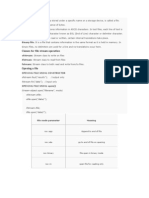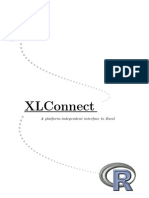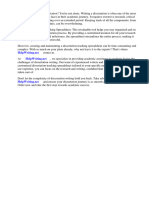Generate A Unique Sequential Filename.
Generate A Unique Sequential Filename.
Uploaded by
Subhasish PatnaikCopyright:
Available Formats
Generate A Unique Sequential Filename.
Generate A Unique Sequential Filename.
Uploaded by
Subhasish PatnaikOriginal Description:
Original Title
Copyright
Available Formats
Share this document
Did you find this document useful?
Is this content inappropriate?
Copyright:
Available Formats
Generate A Unique Sequential Filename.
Generate A Unique Sequential Filename.
Uploaded by
Subhasish PatnaikCopyright:
Available Formats
Excel Generate a unique sequential filename.
Ease of Use Intermediate Version tested with 2003 Submitted by: Kenneth Hobs Description: A unique full path with filename is generated from a folder and base filename. N either folder nor filename need exist. If they do, gaps in the sequential filena mes are filled first. Requires v5 of shell32.dll which is included in XP SP2 and Windows Server 2003. It is my Vista x64 as well. Discussion: This concept can be used in any VBA code where one needs to generate a unique fi lename with a prefix or base name. The filenames generated are from a folder nam e and a base filename though neither need exist. e.g. c:\file.xls, c:\file (1).x ls, c:\file (2).xls, etc. Basically, two API's are shown. Four custom functions enable the user to pass the folder name and base filename separately or as one s tring. The concept of this macro is a bit similar to tstav's KB entry to produce a unique suffix for a filename. In the XLS attachment, I have compared this met hod to tstav's method. http://vbaexpress.com/kb/getarticle.php?kb_id=1008 Code: instructions for use Sub Test1() Dim s As String s = fMakeAnotherUnique("", Environ("username") & ".xls", ThisWorkbook.Path) MsgBox s, vbInformation, "MsgBox1: fMakeAnotherUnique()" s = fMakeAnotherUnique("", ThisWorkbook.Name, ThisWorkbook.Path) MsgBox s, vbInformation, "MsgBox2: fMakeAnotherUnique()" End Sub Sub Test2() Dim s As String s = MakeAnotherUnique(ThisWorkbook.Path & "\" & Environ("username") & ".xls" ) MsgBox s, vbInformation, "MsgBox3: MakeAntoherUnique()" s = MakeAnotherUnique(ThisWorkbook.FullName) MsgBox s, vbInformation, "MsgBox4: MakeAntoherUnique()" End Sub Sub Test3() Dim s As String s = fMakeUnique("", Environ("username") & ".xls", ThisWorkbook.Path) MsgBox s, vbInformation, "MsgBox5: fMakeUnique()" s = fMakeUnique("", ThisWorkbook.Name, ThisWorkbook.Path) MsgBox s, vbInformation, "MsgBox6: fMakeUnique()" End Sub Sub Test4() Dim s As String s = MakeUnique(ThisWorkbook.Path & "\" & Environ("username") & ".xls") MsgBox s, vbInformation, "MsgBox7: MakeUnique()" s = MakeUnique(ThisWorkbook.FullName) MsgBox s, vbInformation, "MsgBox8: MakeUnique()" End Sub
'Put this part below in a separate module. Const Max_Path As String = 260 'http://msdn.microsoft.com/en-us/library/bb776479.aspx Public Declare Function PathYetAnotherMakeUniqueName _ Lib "shell32.dll" _ ( _ ByVal pszUniqueName As String, _ ByVal pszPath As String, _ ByVal pszShort As String, _ ByVal pszFileSpec As String _ ) As Boolean 'http://msdn.microsoft.com/en-us/library/bb776479.aspx Public Declare Function PathMakeUniqueName _ Lib "shell32.dll" _ ( _ ByVal pszUniqueName As String, _ ByVal cchMax As Long, _ ByVal pszTemplate As String, _ ByVal pszLongPlate As String, _ ByVal pszDir As String _ ) As Boolean Function fMakeAnotherUnique(vShortTemplate, vLongTemplate, vFolder) As String 'vFolder can end in trailing backslash or not Dim rc As Boolean, vUniqueName As String, s As String vUniqueName = Space$(Max_Path) rc = PathYetAnotherMakeUniqueName(vUniqueName, StrConv(vFolder, vbUnicode), _ StrConv(vShortTemplate, vbUnicode), StrConv(vLongTemplate, vbUnicode)) If rc Then vUniqueName = StrConv(vUniqueName, vbFromUnicode) fMakeAnotherUnique = vUniqueName End If End Function Function MakeAnotherUnique(filespec As String) As String MakeAnotherUnique = fMakeAnotherUnique("", GetFileName(filespec), GetFolderN ame(filespec)) End Function Function fMakeUnique(vShortTemplate, vLongTemplate, vFolder) As String 'vFolder can end in trailing backslash or not Dim rc As Boolean, vUniqueName As String, s As String vUniqueName = Space$(Max_Path) rc = PathMakeUniqueName(vUniqueName, Max_Path, StrConv(vShortTemplate, vbUni code), _ StrConv(vLongTemplate, vbUnicode), StrConv(vFolder, vbUnicode)) If rc Then vUniqueName = StrConv(vUniqueName, vbFromUnicode) fMakeUnique = vUniqueName End If End Function Function MakeUnique(filespec As String) As String MakeUnique = fMakeUnique("", GetFileName(filespec), GetFolderName(filespec)) End Function Function GetFileName(filespec As String) As String
Dim p1 As Integer, p2 As Integer p1 = InStrRev(filespec, "\") p2 = Len(filespec) - p1 GetFileName = Mid$(filespec, p1 + 1, p2) End Function Function GetFolderName(filespec As String) As String Dim p1 As Integer p1 = InStrRev(filespec, "\") GetFolderName = Left$(filespec, p1) End Function
How to use: 1. Open the example XLS file and click each of Test buttons, or: 2. Copy the above code. 3. Open any workbook. 4. Press Alt + F11 to open the Visual Basic Editor (VBE). 5. From the Menu, choose Insert-Module. 6. Paste the code into the right-hand code window. 7. Move the Test1 to Test4 Subs to the end or cut and paste to another Modu le. 8. Close the VBE, save the file if desired. Test the code: 1. Open the example XLS file and click each of Test buttons. 2. Save the file with names like those generated and re-click the Test butt ons. 3. Note how the filenames are generated. 4. After saving the workbook with filenames that have (2).xls , (3).xls, (4 ).xls and such, delete one in the middle and click the Test buttons to note how the next generated name is the one that was deleted. Sample File: PathYetAnotherMakeUniqueName.zip 23.79KB
You might also like
- Excel Lesson 02Document23 pagesExcel Lesson 02Abdreyll Gerard100% (1)
- Excel Bill of Materials Bom TemplateDocument9 pagesExcel Bill of Materials Bom TemplateMohammed SuhailNo ratings yet
- VB Script PrimerDocument5 pagesVB Script PrimerMihaiNo ratings yet
- Week 3Document10 pagesWeek 3Asadullah ChoudharyNo ratings yet
- Translation Rules: It Contains Regular Expressions and Code SegmentsDocument22 pagesTranslation Rules: It Contains Regular Expressions and Code SegmentsAnujNo ratings yet
- Ring Programming Language Book - Part 15 of 84Document10 pagesRing Programming Language Book - Part 15 of 84Mahmoud Samir FayedNo ratings yet
- Python Notes - 4Document23 pagesPython Notes - 4Prasad S RNo ratings yet
- Chapter 3 - I-ODocument13 pagesChapter 3 - I-OTalegeta zemechaNo ratings yet
- Here Is The Code of Getsystemproperties - Java: ImportDocument10 pagesHere Is The Code of Getsystemproperties - Java: ImportriyaNo ratings yet
- SAX Parsing With PythonDocument3 pagesSAX Parsing With Pythonmarquimf2008No ratings yet
- Banking Guru 99Document13 pagesBanking Guru 99demudu donkaNo ratings yet
- Visual ScriptsDocument15 pagesVisual ScriptscarlosNo ratings yet
- Classes For File Stream Operation: Stream-Object - Open ("Filename", Mode)Document9 pagesClasses For File Stream Operation: Stream-Object - Open ("Filename", Mode)munoNo ratings yet
- IO and StreamsDocument13 pagesIO and Streamsxn3kafNo ratings yet
- LUbvbDocument6 pagesLUbvbIstiaq Hasan RifatNo ratings yet
- Os Lab Manual FinalDocument57 pagesOs Lab Manual Final2243059100% (2)
- XidelDocument10 pagesXideltmp_rootsNo ratings yet
- How To Use Windows Commands in BODSDocument3 pagesHow To Use Windows Commands in BODSyella reddyNo ratings yet
- Programming With PHP and MySQL-2Document20 pagesProgramming With PHP and MySQL-2Broken SoulNo ratings yet
- Reading Text Files in VBADocument6 pagesReading Text Files in VBAaaronphamNo ratings yet
- Q.What Are The Uses of File Object: Except (Exception1, Exception2, Exceptionn) As EDocument8 pagesQ.What Are The Uses of File Object: Except (Exception1, Exception2, Exceptionn) As ESonu 05No ratings yet
- TutorialsDocument24 pagesTutorialsaksumgereNo ratings yet
- Opening Files: Mode DescriptionDocument6 pagesOpening Files: Mode DescriptionLokesh SNo ratings yet
- DOMDocument7 pagesDOMgopivanamNo ratings yet
- Practical 2-3Document3 pagesPractical 2-3warlord 56No ratings yet
- 12 Cs Cbse QP ProgramsDocument10 pages12 Cs Cbse QP Programsroyalfancy704No ratings yet
- QTP Code ReferenceDocument58 pagesQTP Code Referencevineel_kiranNo ratings yet
- Java Write File ReadDocument5 pagesJava Write File ReadRPMSMNo ratings yet
- Reading File X LsDocument5 pagesReading File X LsRPMSMNo ratings yet
- 3.6.6 Lab - Parse Different Data Types With PythonDocument6 pages3.6.6 Lab - Parse Different Data Types With PythonWilly DinataNo ratings yet
- Lab PGMDocument4 pagesLab PGMshivani100codingNo ratings yet
- Clips Cogai Paper PDFDocument8 pagesClips Cogai Paper PDFVictor DanielNo ratings yet
- Introduction To Functions in Matlab: SyntaxDocument8 pagesIntroduction To Functions in Matlab: Syntaxsaran gulNo ratings yet
- 4 UNIT CH1 Files and ExceptionsDocument57 pages4 UNIT CH1 Files and ExceptionsDeependraNo ratings yet
- Working With Microsoft Excel in RDocument24 pagesWorking With Microsoft Excel in RNagapavan ChNo ratings yet
- File Handling in C++Document17 pagesFile Handling in C++Sunil SuryawanshiNo ratings yet
- PowerShell File Search AutomationDocument3 pagesPowerShell File Search AutomationkhalidNo ratings yet
- Java ProgramsDocument42 pagesJava ProgramsIulia AndreeaNo ratings yet
- Document 26Document18 pagesDocument 26Argha SenNo ratings yet
- Module 4Document17 pagesModule 4sushma-icbNo ratings yet
- 3.6.6 Lab - Parse Different Data Types With PythonDocument9 pages3.6.6 Lab - Parse Different Data Types With PythonSamuel GarciaNo ratings yet
- Mod3 2Document10 pagesMod3 2Syed HussainNo ratings yet
- Vba Access Code ExpertDocument7 pagesVba Access Code ExpertBenjaminBegovicNo ratings yet
- Python Programming BookDocument250 pagesPython Programming BookKənan MəmmədliNo ratings yet
- Excel VBA Code To Copy FileDocument3 pagesExcel VBA Code To Copy FileLop LopmanNo ratings yet
- EvilclippyDocument16 pagesEvilclippymts almuttaqinNo ratings yet
- INF 208 Programming - Java: File ProcessingDocument23 pagesINF 208 Programming - Java: File ProcessingAshiru kattoNo ratings yet
- File Handling in C With Examples (Fopen, Fread, Fwrite, Fseek)Document9 pagesFile Handling in C With Examples (Fopen, Fread, Fwrite, Fseek)Sabir AhmedNo ratings yet
- nodejs_file_systemDocument15 pagesnodejs_file_systemanshkmr991No ratings yet
- An XML File Which Will Display The Book Information and DTDDocument7 pagesAn XML File Which Will Display The Book Information and DTDAdithya VardhanNo ratings yet
- Python CommandsDocument3 pagesPython Commandssiswand.1989No ratings yet
- Basic Unix Commands For DBADocument8 pagesBasic Unix Commands For DBAmujtabamaliNo ratings yet
- A - 3 - 6 - 6 - Parse Different - Data - Types - Python2Document8 pagesA - 3 - 6 - 6 - Parse Different - Data - Types - Python2Eduardo Manuel Sandoval SalazarNo ratings yet
- 29 Wlanguage Code SamplesDocument6 pages29 Wlanguage Code SamplesEmiliano SuarezNo ratings yet
- .Maybe Foudre - Xls.malDocument7 pages.Maybe Foudre - Xls.malTomer BarNo ratings yet
- Designing With Exceptions: Guidelines and Tips On When and How To Use ExceptionsDocument7 pagesDesigning With Exceptions: Guidelines and Tips On When and How To Use ExceptionsOmar FerraNo ratings yet
- Files in Folders and SubfoldersDocument6 pagesFiles in Folders and SubfoldersYamini ShindeNo ratings yet
- Excel UnlockerDocument13 pagesExcel UnlockerwnoivijtNo ratings yet
- Go by Example:: Base64 EncodingDocument4 pagesGo by Example:: Base64 EncodinglulueaNo ratings yet
- 2013 - Notes - R Trinker'S - NotesDocument274 pages2013 - Notes - R Trinker'S - NotesCody WrightNo ratings yet
- Java Programming Tutorial With Screen Shots & Many Code ExampleFrom EverandJava Programming Tutorial With Screen Shots & Many Code ExampleNo ratings yet
- CNC RouterDocument9 pagesCNC RouterSubhasish PatnaikNo ratings yet
- Au Sde Courses ListDocument3 pagesAu Sde Courses ListSubhasish PatnaikNo ratings yet
- Employees' Provident Fund Scheme, 1952: Form-19Document3 pagesEmployees' Provident Fund Scheme, 1952: Form-19Subhasish PatnaikNo ratings yet
- QC On A/C of Burnt Rejection: Item DescriptionDocument12 pagesQC On A/C of Burnt Rejection: Item DescriptionSubhasish PatnaikNo ratings yet
- Detailed Advertisement Recruitment of Non ExecutivesDocument6 pagesDetailed Advertisement Recruitment of Non ExecutivesSubhasish PatnaikNo ratings yet
- Group PolicyDocument45 pagesGroup PolicySubhasish PatnaikNo ratings yet
- State of Children in OrissaDocument147 pagesState of Children in OrissaSubhasish Patnaik100% (1)
- ExcelDocument3 pagesExcelSubhasish PatnaikNo ratings yet
- Out of Step Protective Functions and Challenges in Testing Paper IPTS 2015 Proschek ENUDocument6 pagesOut of Step Protective Functions and Challenges in Testing Paper IPTS 2015 Proschek ENUengrdavi Davidean FloresNo ratings yet
- Process Engineer User GuideDocument50 pagesProcess Engineer User GuidebbhattNo ratings yet
- FBL3N Account Line Item AnalysisDocument5 pagesFBL3N Account Line Item AnalysisDinesh KumarNo ratings yet
- Bug DetailsDocument91 pagesBug Detailsapi-3846919100% (4)
- LT Power Cad HelpDocument28 pagesLT Power Cad Helpshiva shakthyNo ratings yet
- How To Seek The Commodity CodesDocument15 pagesHow To Seek The Commodity CodesErick SobariNo ratings yet
- Q1 eTech-EXAMDocument5 pagesQ1 eTech-EXAMSamantha SarazaNo ratings yet
- ITM Reading Material 2021Document70 pagesITM Reading Material 2021Pretam Mondal100% (1)
- 02 - Data Analytics Prefessional CourseDocument16 pages02 - Data Analytics Prefessional CourseSandhya Kuppala100% (1)
- Spend AnalysisDocument4 pagesSpend Analysisffast69No ratings yet
- CATS Web User Guide For TempStaff StudentDocument27 pagesCATS Web User Guide For TempStaff StudentMarcus GohNo ratings yet
- MI03 - Lab ManualDocument80 pagesMI03 - Lab ManualAlberto EstrellaNo ratings yet
- Excel and Powerpoint PresentationDocument66 pagesExcel and Powerpoint PresentationJerecho FramilNo ratings yet
- A Note On Excel Random FunctionDocument2 pagesA Note On Excel Random FunctiongiercejjenowskiNo ratings yet
- MANUAL - SmartFit 3D Training ManualDocument81 pagesMANUAL - SmartFit 3D Training ManualCarlosQuelart100% (2)
- Spreadsheets and The Data Life CycleDocument11 pagesSpreadsheets and The Data Life CycleKiel RodelasNo ratings yet
- GgwplalanaDocument11 pagesGgwplalanaRenny PasaribuNo ratings yet
- Computer Application Course OutlineDocument15 pagesComputer Application Course OutlineShehnum MoazzamNo ratings yet
- Syllabus PDFDocument4 pagesSyllabus PDFDon NewNo ratings yet
- SP3D Drawings and Reports S2 TutorialDocument25 pagesSP3D Drawings and Reports S2 Tutorialhuyanhsd12No ratings yet
- All PileDocument32 pagesAll PileSipri GamurNo ratings yet
- Student Assistant ResumeDocument7 pagesStudent Assistant Resumef5dthdcd100% (2)
- Applied Business Tools Module (Midterm) (No Self Activity)Document51 pagesApplied Business Tools Module (Midterm) (No Self Activity)Verdida JovelynNo ratings yet
- Module 4 Introduction To Spreadsheets - Models v2Document12 pagesModule 4 Introduction To Spreadsheets - Models v2Kosuru ratnasaiNo ratings yet
- Alv ReportDocument15 pagesAlv Reportsanjeevpandey2012No ratings yet
- Wesley Methodist School Penang (International) : Mid Year Examination - YearDocument4 pagesWesley Methodist School Penang (International) : Mid Year Examination - YearHachi KoNo ratings yet
- Dissertation Tracking SpreadsheetDocument4 pagesDissertation Tracking SpreadsheetWhoCanWriteMyPaperForMeCanada50% (2)
- Excel Formulas & Functions 2023Document266 pagesExcel Formulas & Functions 2023Alexander Jose Chacin NavarroNo ratings yet

































































































